Investment Appraisal Techniques, IRR and Project Recommendation
VerifiedAdded on 2023/06/14
|6
|1228
|142
Report
AI Summary
This report provides an overview of investment appraisal techniques, including payback period, net present value (NPV), accounting rate of return (ARR), and internal rate of return (IRR), to aid in long-term project investment decisions. It discusses the importance of these techniques in assessing project feasibility, managing long-term investments, maximizing wealth, and making irreversible decisions. The report analyzes two projects, A20 and B25, using these techniques, recommending Project A20 based on its higher IRR and shorter payback period, despite B25 having a slightly higher NPV. The director's assertion that IRR will exceed 7% is validated, as both projects demonstrate IRR values above this threshold, making Project A20 the viable option for investment. Desklib offers a wealth of study resources, including solved assignments and past papers, to support students in mastering complex topics.
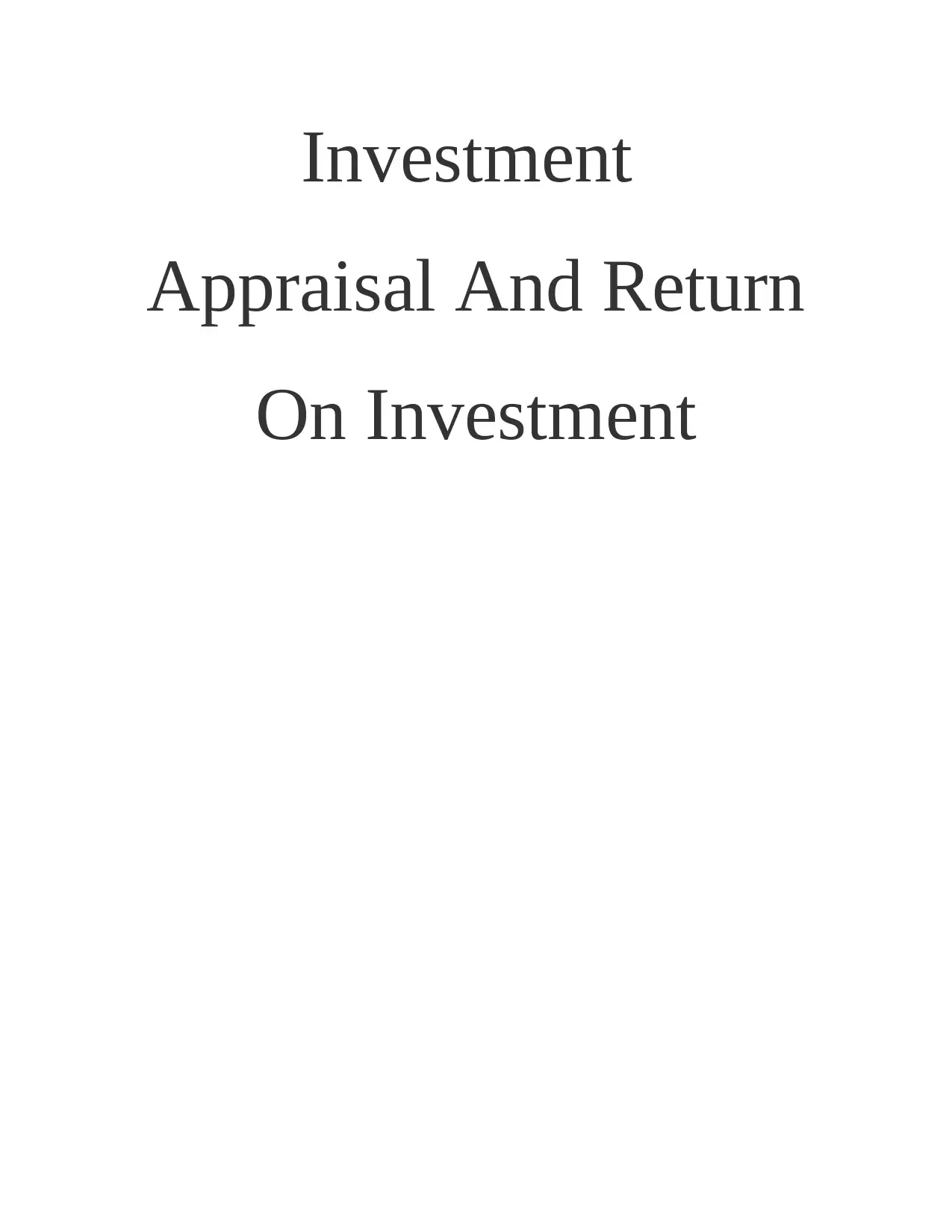
Investment
Appraisal And Return
On Investment
Appraisal And Return
On Investment
Paraphrase This Document
Need a fresh take? Get an instant paraphrase of this document with our AI Paraphraser
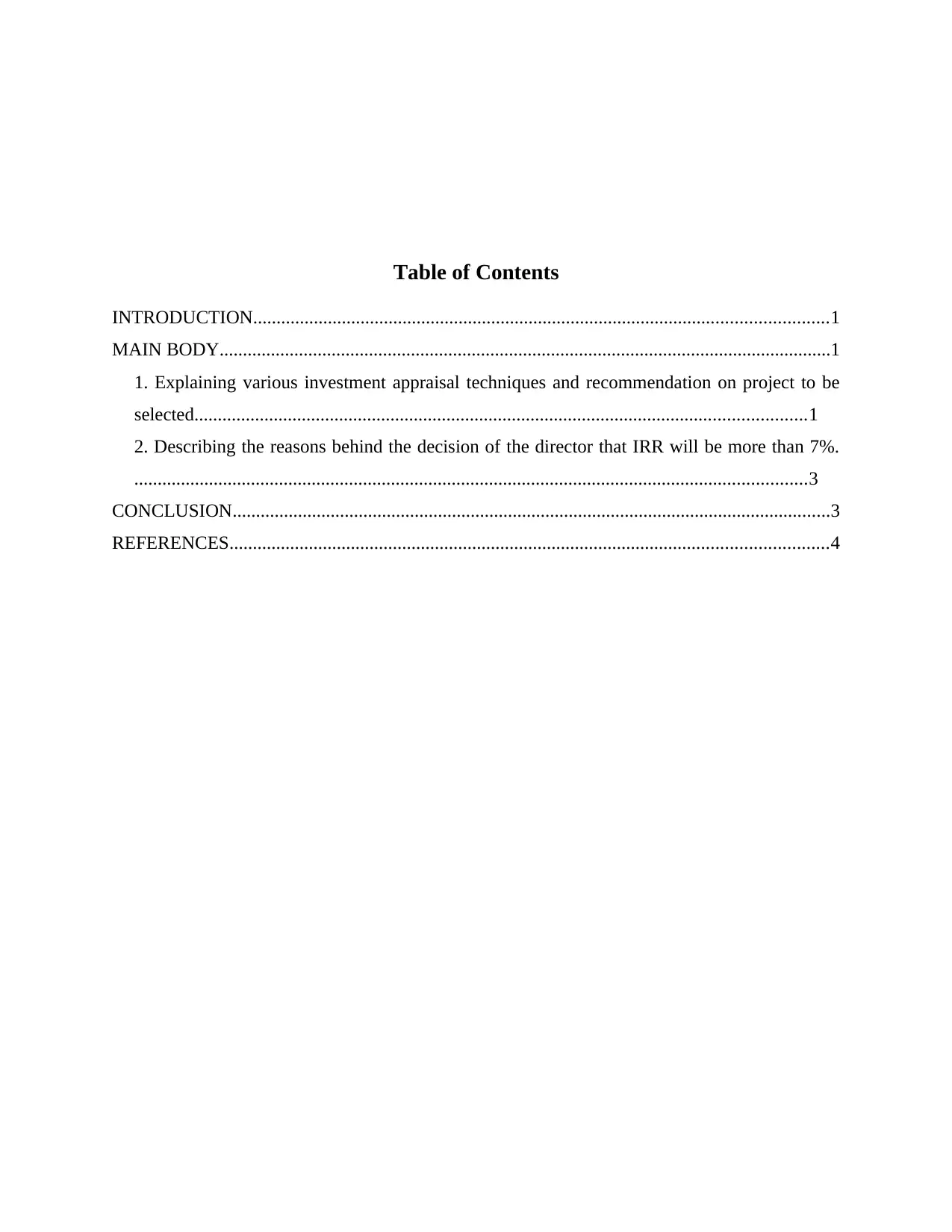
Table of Contents
INTRODUCTION...........................................................................................................................1
MAIN BODY...................................................................................................................................1
1. Explaining various investment appraisal techniques and recommendation on project to be
selected...................................................................................................................................1
2. Describing the reasons behind the decision of the director that IRR will be more than 7%.
................................................................................................................................................3
CONCLUSION................................................................................................................................3
REFERENCES................................................................................................................................4
INTRODUCTION...........................................................................................................................1
MAIN BODY...................................................................................................................................1
1. Explaining various investment appraisal techniques and recommendation on project to be
selected...................................................................................................................................1
2. Describing the reasons behind the decision of the director that IRR will be more than 7%.
................................................................................................................................................3
CONCLUSION................................................................................................................................3
REFERENCES................................................................................................................................4
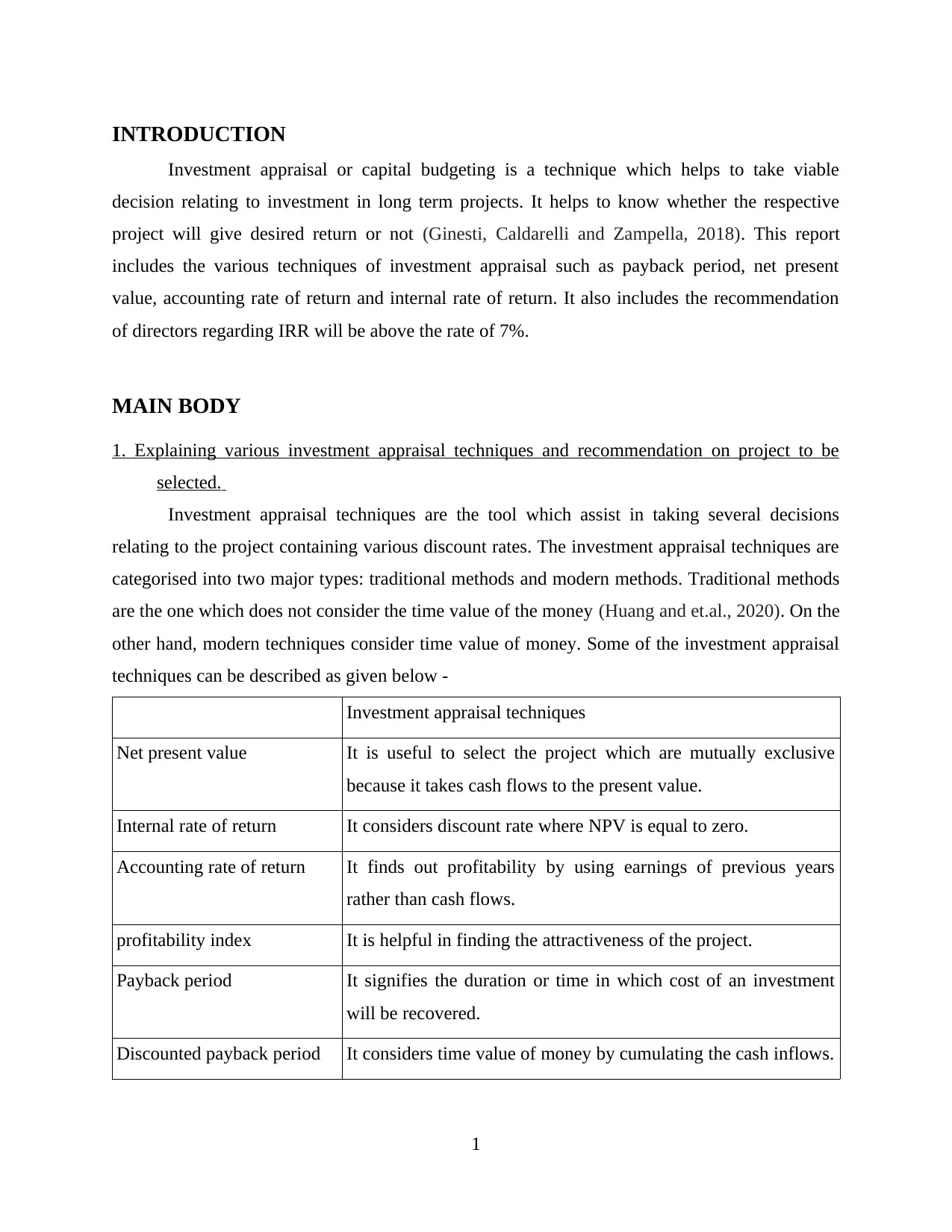
INTRODUCTION
Investment appraisal or capital budgeting is a technique which helps to take viable
decision relating to investment in long term projects. It helps to know whether the respective
project will give desired return or not (Ginesti, Caldarelli and Zampella, 2018). This report
includes the various techniques of investment appraisal such as payback period, net present
value, accounting rate of return and internal rate of return. It also includes the recommendation
of directors regarding IRR will be above the rate of 7%.
MAIN BODY
1. Explaining various investment appraisal techniques and recommendation on project to be
selected.
Investment appraisal techniques are the tool which assist in taking several decisions
relating to the project containing various discount rates. The investment appraisal techniques are
categorised into two major types: traditional methods and modern methods. Traditional methods
are the one which does not consider the time value of the money (Huang and et.al., 2020). On the
other hand, modern techniques consider time value of money. Some of the investment appraisal
techniques can be described as given below -
Investment appraisal techniques
Net present value It is useful to select the project which are mutually exclusive
because it takes cash flows to the present value.
Internal rate of return It considers discount rate where NPV is equal to zero.
Accounting rate of return It finds out profitability by using earnings of previous years
rather than cash flows.
profitability index It is helpful in finding the attractiveness of the project.
Payback period It signifies the duration or time in which cost of an investment
will be recovered.
Discounted payback period It considers time value of money by cumulating the cash inflows.
1
Investment appraisal or capital budgeting is a technique which helps to take viable
decision relating to investment in long term projects. It helps to know whether the respective
project will give desired return or not (Ginesti, Caldarelli and Zampella, 2018). This report
includes the various techniques of investment appraisal such as payback period, net present
value, accounting rate of return and internal rate of return. It also includes the recommendation
of directors regarding IRR will be above the rate of 7%.
MAIN BODY
1. Explaining various investment appraisal techniques and recommendation on project to be
selected.
Investment appraisal techniques are the tool which assist in taking several decisions
relating to the project containing various discount rates. The investment appraisal techniques are
categorised into two major types: traditional methods and modern methods. Traditional methods
are the one which does not consider the time value of the money (Huang and et.al., 2020). On the
other hand, modern techniques consider time value of money. Some of the investment appraisal
techniques can be described as given below -
Investment appraisal techniques
Net present value It is useful to select the project which are mutually exclusive
because it takes cash flows to the present value.
Internal rate of return It considers discount rate where NPV is equal to zero.
Accounting rate of return It finds out profitability by using earnings of previous years
rather than cash flows.
profitability index It is helpful in finding the attractiveness of the project.
Payback period It signifies the duration or time in which cost of an investment
will be recovered.
Discounted payback period It considers time value of money by cumulating the cash inflows.
1
⊘ This is a preview!⊘
Do you want full access?
Subscribe today to unlock all pages.

Trusted by 1+ million students worldwide
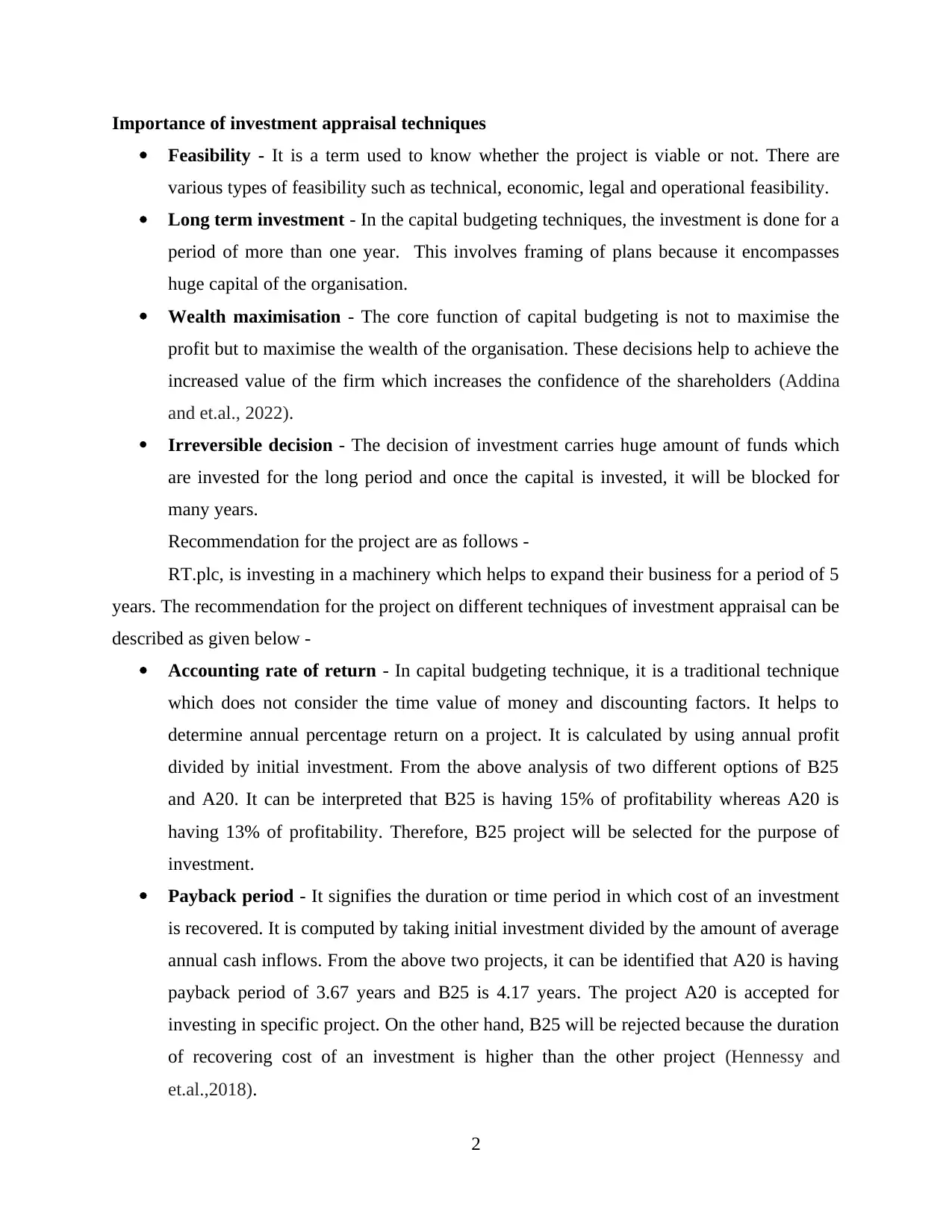
Importance of investment appraisal techniques
Feasibility - It is a term used to know whether the project is viable or not. There are
various types of feasibility such as technical, economic, legal and operational feasibility.
Long term investment - In the capital budgeting techniques, the investment is done for a
period of more than one year. This involves framing of plans because it encompasses
huge capital of the organisation.
Wealth maximisation - The core function of capital budgeting is not to maximise the
profit but to maximise the wealth of the organisation. These decisions help to achieve the
increased value of the firm which increases the confidence of the shareholders (Addina
and et.al., 2022).
Irreversible decision - The decision of investment carries huge amount of funds which
are invested for the long period and once the capital is invested, it will be blocked for
many years.
Recommendation for the project are as follows -
RT.plc, is investing in a machinery which helps to expand their business for a period of 5
years. The recommendation for the project on different techniques of investment appraisal can be
described as given below -
Accounting rate of return - In capital budgeting technique, it is a traditional technique
which does not consider the time value of money and discounting factors. It helps to
determine annual percentage return on a project. It is calculated by using annual profit
divided by initial investment. From the above analysis of two different options of B25
and A20. It can be interpreted that B25 is having 15% of profitability whereas A20 is
having 13% of profitability. Therefore, B25 project will be selected for the purpose of
investment.
Payback period - It signifies the duration or time period in which cost of an investment
is recovered. It is computed by taking initial investment divided by the amount of average
annual cash inflows. From the above two projects, it can be identified that A20 is having
payback period of 3.67 years and B25 is 4.17 years. The project A20 is accepted for
investing in specific project. On the other hand, B25 will be rejected because the duration
of recovering cost of an investment is higher than the other project (Hennessy and
et.al.,2018).
2
Feasibility - It is a term used to know whether the project is viable or not. There are
various types of feasibility such as technical, economic, legal and operational feasibility.
Long term investment - In the capital budgeting techniques, the investment is done for a
period of more than one year. This involves framing of plans because it encompasses
huge capital of the organisation.
Wealth maximisation - The core function of capital budgeting is not to maximise the
profit but to maximise the wealth of the organisation. These decisions help to achieve the
increased value of the firm which increases the confidence of the shareholders (Addina
and et.al., 2022).
Irreversible decision - The decision of investment carries huge amount of funds which
are invested for the long period and once the capital is invested, it will be blocked for
many years.
Recommendation for the project are as follows -
RT.plc, is investing in a machinery which helps to expand their business for a period of 5
years. The recommendation for the project on different techniques of investment appraisal can be
described as given below -
Accounting rate of return - In capital budgeting technique, it is a traditional technique
which does not consider the time value of money and discounting factors. It helps to
determine annual percentage return on a project. It is calculated by using annual profit
divided by initial investment. From the above analysis of two different options of B25
and A20. It can be interpreted that B25 is having 15% of profitability whereas A20 is
having 13% of profitability. Therefore, B25 project will be selected for the purpose of
investment.
Payback period - It signifies the duration or time period in which cost of an investment
is recovered. It is computed by taking initial investment divided by the amount of average
annual cash inflows. From the above two projects, it can be identified that A20 is having
payback period of 3.67 years and B25 is 4.17 years. The project A20 is accepted for
investing in specific project. On the other hand, B25 will be rejected because the duration
of recovering cost of an investment is higher than the other project (Hennessy and
et.al.,2018).
2
Paraphrase This Document
Need a fresh take? Get an instant paraphrase of this document with our AI Paraphraser
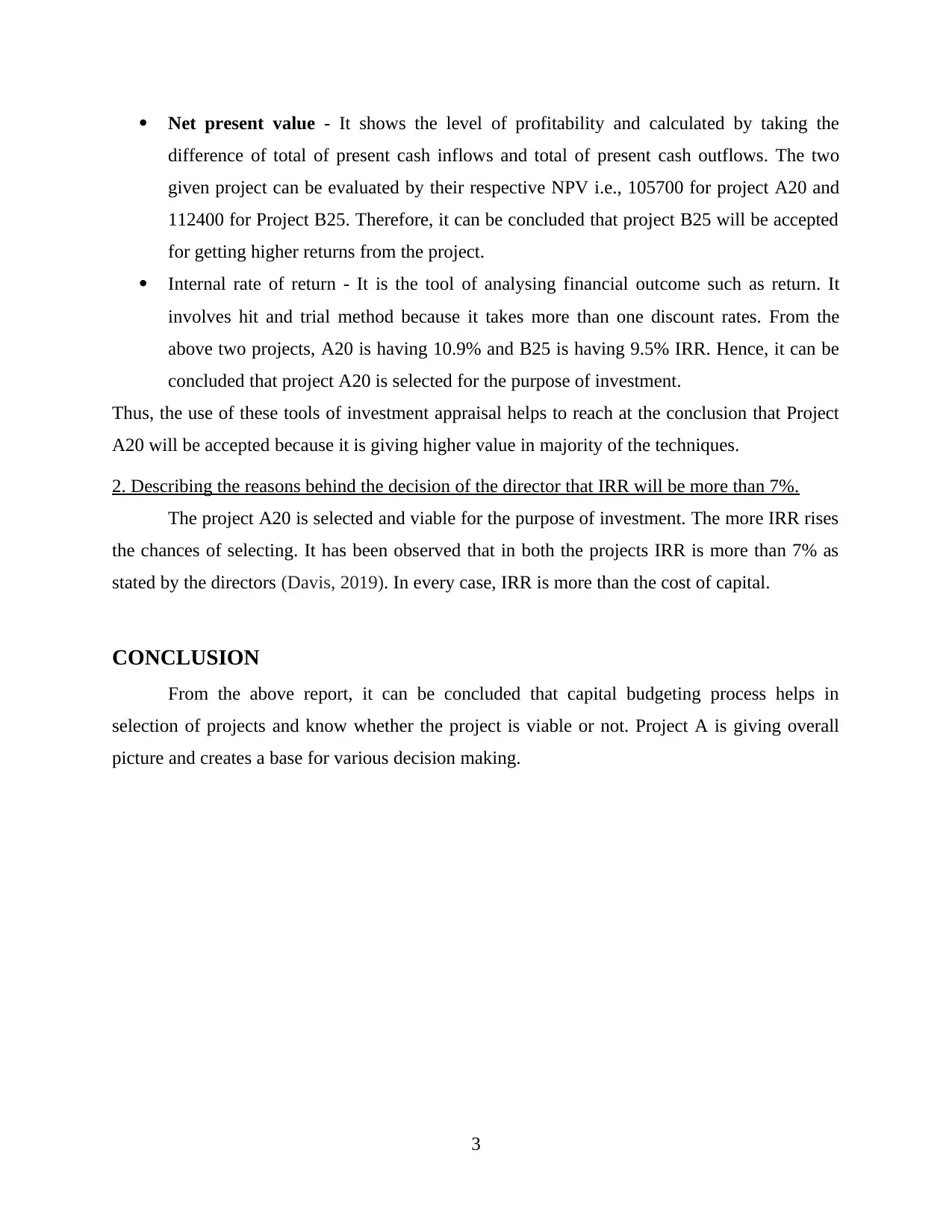
Net present value - It shows the level of profitability and calculated by taking the
difference of total of present cash inflows and total of present cash outflows. The two
given project can be evaluated by their respective NPV i.e., 105700 for project A20 and
112400 for Project B25. Therefore, it can be concluded that project B25 will be accepted
for getting higher returns from the project.
Internal rate of return - It is the tool of analysing financial outcome such as return. It
involves hit and trial method because it takes more than one discount rates. From the
above two projects, A20 is having 10.9% and B25 is having 9.5% IRR. Hence, it can be
concluded that project A20 is selected for the purpose of investment.
Thus, the use of these tools of investment appraisal helps to reach at the conclusion that Project
A20 will be accepted because it is giving higher value in majority of the techniques.
2. Describing the reasons behind the decision of the director that IRR will be more than 7%.
The project A20 is selected and viable for the purpose of investment. The more IRR rises
the chances of selecting. It has been observed that in both the projects IRR is more than 7% as
stated by the directors (Davis, 2019). In every case, IRR is more than the cost of capital.
CONCLUSION
From the above report, it can be concluded that capital budgeting process helps in
selection of projects and know whether the project is viable or not. Project A is giving overall
picture and creates a base for various decision making.
3
difference of total of present cash inflows and total of present cash outflows. The two
given project can be evaluated by their respective NPV i.e., 105700 for project A20 and
112400 for Project B25. Therefore, it can be concluded that project B25 will be accepted
for getting higher returns from the project.
Internal rate of return - It is the tool of analysing financial outcome such as return. It
involves hit and trial method because it takes more than one discount rates. From the
above two projects, A20 is having 10.9% and B25 is having 9.5% IRR. Hence, it can be
concluded that project A20 is selected for the purpose of investment.
Thus, the use of these tools of investment appraisal helps to reach at the conclusion that Project
A20 will be accepted because it is giving higher value in majority of the techniques.
2. Describing the reasons behind the decision of the director that IRR will be more than 7%.
The project A20 is selected and viable for the purpose of investment. The more IRR rises
the chances of selecting. It has been observed that in both the projects IRR is more than 7% as
stated by the directors (Davis, 2019). In every case, IRR is more than the cost of capital.
CONCLUSION
From the above report, it can be concluded that capital budgeting process helps in
selection of projects and know whether the project is viable or not. Project A is giving overall
picture and creates a base for various decision making.
3
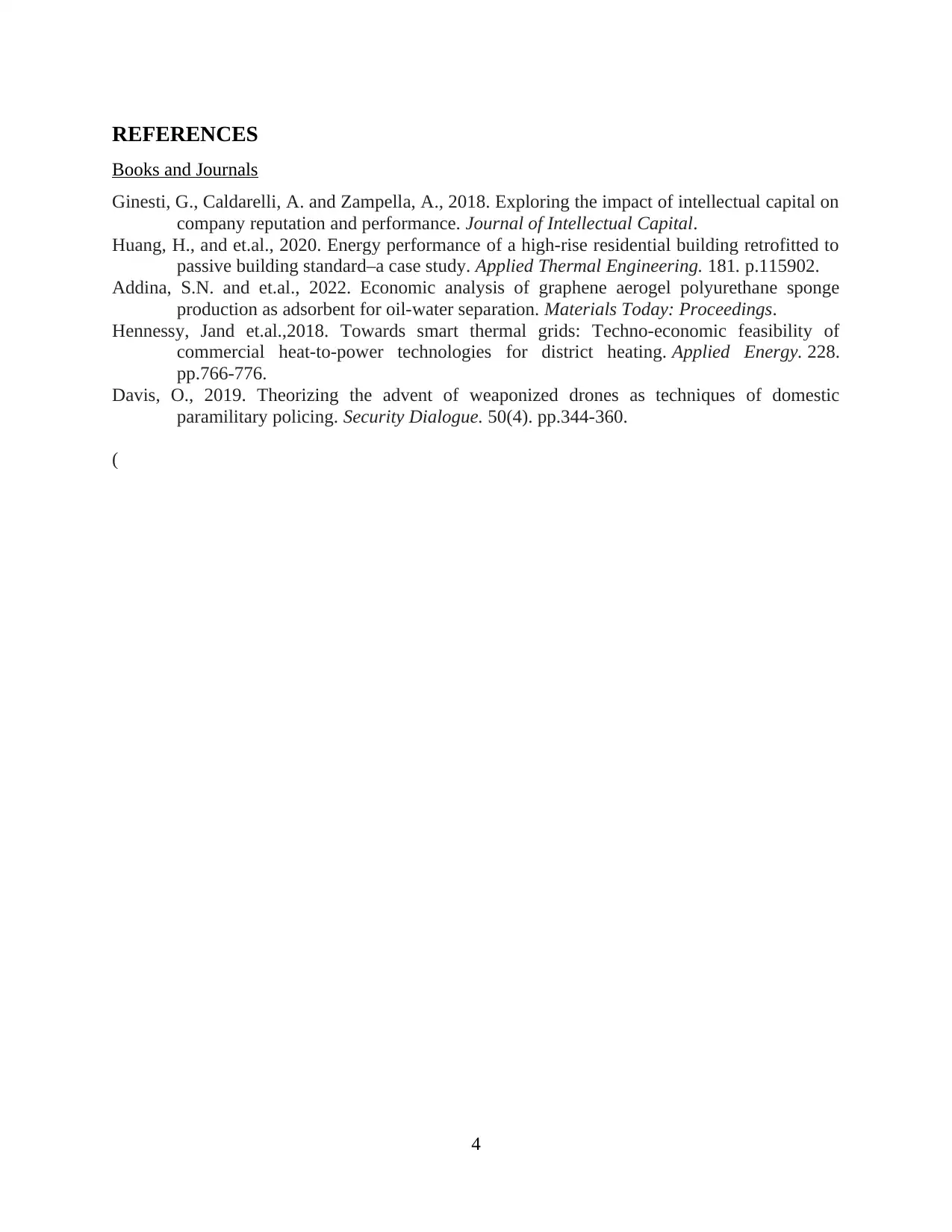
REFERENCES
Books and Journals
Ginesti, G., Caldarelli, A. and Zampella, A., 2018. Exploring the impact of intellectual capital on
company reputation and performance. Journal of Intellectual Capital.
Huang, H., and et.al., 2020. Energy performance of a high-rise residential building retrofitted to
passive building standard–a case study. Applied Thermal Engineering. 181. p.115902.
Addina, S.N. and et.al., 2022. Economic analysis of graphene aerogel polyurethane sponge
production as adsorbent for oil-water separation. Materials Today: Proceedings.
Hennessy, Jand et.al.,2018. Towards smart thermal grids: Techno-economic feasibility of
commercial heat-to-power technologies for district heating. Applied Energy. 228.
pp.766-776.
Davis, O., 2019. Theorizing the advent of weaponized drones as techniques of domestic
paramilitary policing. Security Dialogue. 50(4). pp.344-360.
(
4
Books and Journals
Ginesti, G., Caldarelli, A. and Zampella, A., 2018. Exploring the impact of intellectual capital on
company reputation and performance. Journal of Intellectual Capital.
Huang, H., and et.al., 2020. Energy performance of a high-rise residential building retrofitted to
passive building standard–a case study. Applied Thermal Engineering. 181. p.115902.
Addina, S.N. and et.al., 2022. Economic analysis of graphene aerogel polyurethane sponge
production as adsorbent for oil-water separation. Materials Today: Proceedings.
Hennessy, Jand et.al.,2018. Towards smart thermal grids: Techno-economic feasibility of
commercial heat-to-power technologies for district heating. Applied Energy. 228.
pp.766-776.
Davis, O., 2019. Theorizing the advent of weaponized drones as techniques of domestic
paramilitary policing. Security Dialogue. 50(4). pp.344-360.
(
4
⊘ This is a preview!⊘
Do you want full access?
Subscribe today to unlock all pages.

Trusted by 1+ million students worldwide
1 out of 6
Related Documents
Your All-in-One AI-Powered Toolkit for Academic Success.
+13062052269
info@desklib.com
Available 24*7 on WhatsApp / Email
![[object Object]](/_next/static/media/star-bottom.7253800d.svg)
Unlock your academic potential
Copyright © 2020–2025 A2Z Services. All Rights Reserved. Developed and managed by ZUCOL.




